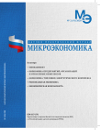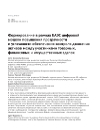Formation of a digital increase model within the EAEU transparency and success of ensuring control over the movement of assets between participants in commodity, financial and property transactions
DOI: 10.33917/mic-2.91.2020.5-12
The article discusses the problems of creating a digital model for increasing transparency and the success of ensuring control over the movement of assets between participants in commodity, financial and property transactions within the framework of the EAEU financial system. It is proposed to increase the observability of any segments of the financial system, which can be digitally structured by electronic digital identification of each currency in the monitoring spaces of digital financial assets. The results of the analysis can be used to optimize the operational dynamics of electronic transactions of explicit alliances and informal cartels of financial agents in the observed space of digital formats of financial communications, taking into account the movement of funds in various forms and denominated in different currencies.
References:
1. Ageev A. I., Radina V. A. Methods of digital economy in terms of management and control activities in the real sector of the economy //Economic strategies. 2019. Vol. 21. № 3 (161). pp. 44-56.
2 . Ageev A. I., Vorozhikhin V. V., Kuzyk B. N., Makhutov N. A., Pobyvaev S. A. Problems of development of trade, clearing, settlement and payment systems that provide optimization interaction between Russian financial institutions and economic entities // Strategic trends in the transformation of socio-economic systems within the digital economy /Materials of the international scientific and practical conference. Moscow: IPR RAS, 2018. pp. 7-9.
3. Ageev A. I., Loginov E. L., Makhutov N. A., Pobyvaev S. A. Formation of system mechanisms of protection of Russian currency and financial resources in the conditions of speculative manipulation of world financial markets //Competitiveness in the global world: economy, science, technology. 2017. № 7-2 (54). pp. 8-11.
4. Ageev A. I., Loginov E. L. Strategic trends of constructed economic reality //Economic strategies. 2012. Vol. 14. № 10 (108). pp. 6-15.
5. Alekseeva D. G. Bank monitoring of suspicious and unusual transactions: legal aspect //Problems of Economics and legal practice. 2019. Vol. 15. № 5. pp. 149-154.
6. Bakhtizin A., Volkova M., Sushko E., Makarov V. Modeling of processes for tracking money laundering and terrorist financing: an agent-oriented approach. Society and Economics. 2018. № 8. pp. 13-25.
7. Zharikov M. V. Conceptual approaches to the formation of the payment system //Theoretical and applied Economics. 2019. № 3. pp. 98-110.
8. Loginov E. L., Grabchak E. P., Grigoriev V. V., Raikov A. N., shkuta A. A. Management of the Russian economy in conditions with an extremely large component of uncertainty in the development of emergency situations and critical lack of information //Problems of security and emergency situations. 2019. № 4. pp. 104-110.
9. Loginov E. L., Shkrablyak A. S. Trends in the development of electronic financial transactions and methods of their control in global telecommunications networks // Engineering physics. 2009. № 9. pp. 47-53.
10. Loginov E. L., shkuta A. A. the financial system of the EEU: the prospective structure of the Union’s financial and economic integration in the conditions of critical disequilibrium of the world financial markets. Moscow: Financial University under the Government of the Russian Federation, 2019. – 155 p.
11. Makarov V. L., Bakhtizin A. R., Sushko E. D., Vasenin V. A., Borisov V. A., Roganov V. A. Agent-oriented models: world experience and technical possibilities of implementation on supercomputers //Bulletin of the Russian Academy of Sciences. 2016. Vol. 86. № 3. p. 252.
12. Maksimova D. A. Development of Eurasian integration as a prerequisite for improving the systems of state financial control in the countries of the Eurasian economic Union //Legal education and science. 2017. № 6. pp. 27-30.
13. Morkovkin D. E., Stroev P. V., Makar S. V. Dynamics of TRANS-national capital flows of the EAEU countries: spatial analysis //Financial life. 2019. № 1. pp. 34-37.
14. Naumov I. V. Theoretical and methodological foundations of the scenario approach to modeling the matrix of financial flows in the regional system //Manager. 2017. № 3 (67). pp. 8-17.
15. Popkov V. V., Berg D. B., Selezneva N. A., Ulyanova E. A. Modeling as a tool for forming a commodity and financial network in the regional economy //Economy of the region. 2015. № 2 (42). pp. 236-246.
16. Yashina N. I., Anikin A.V., Kravchenko V. S. Prospects for the development of information technology infrastructure for financial monitoring in the knowledge economy //Financial research. 2018. № 3 (60). pp. 55-62.



